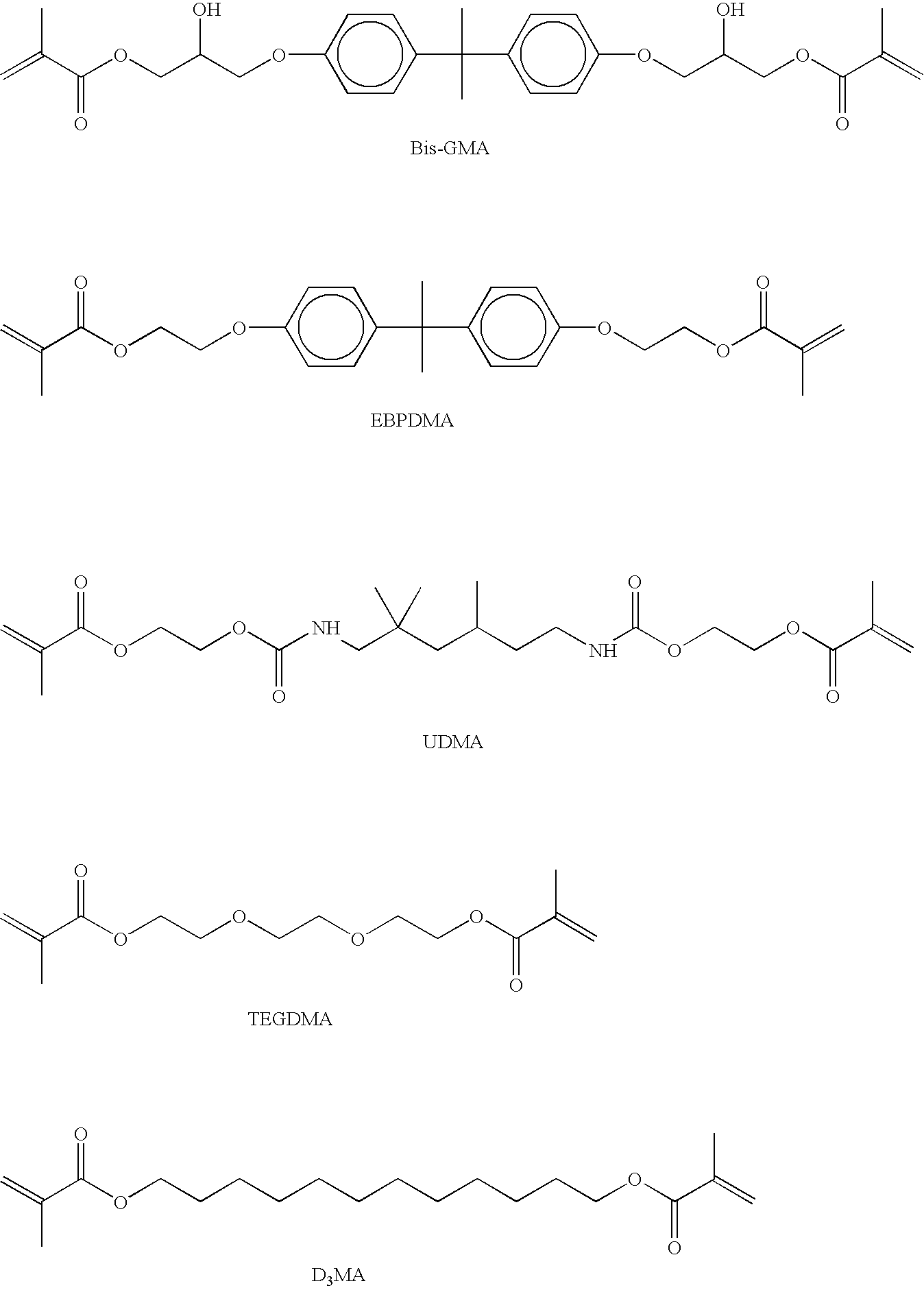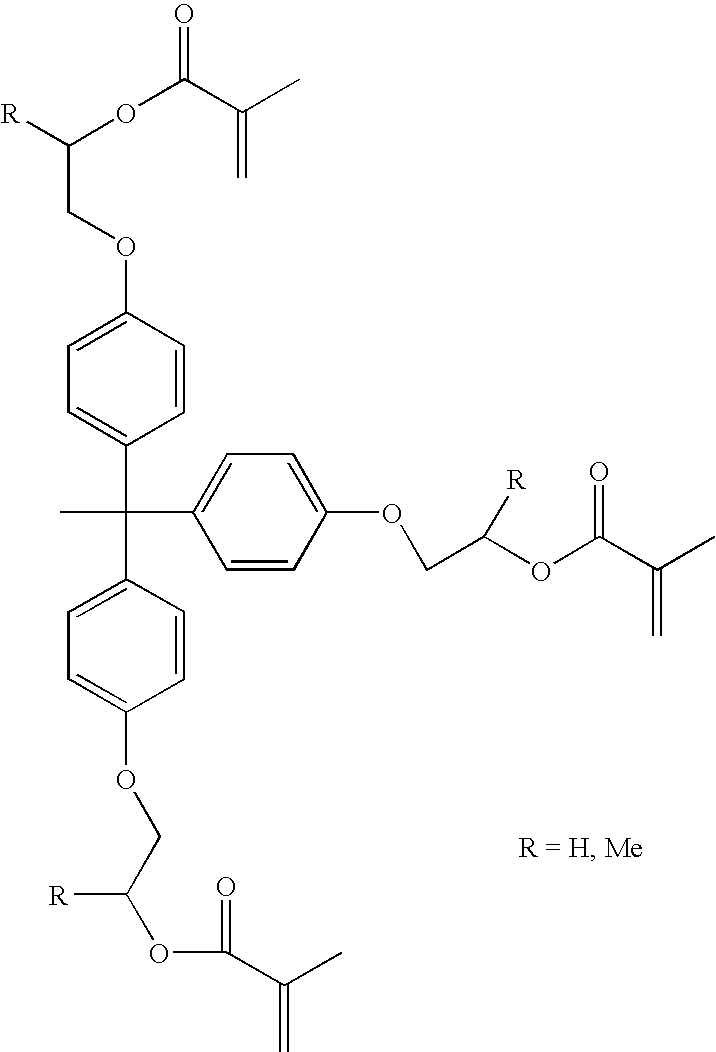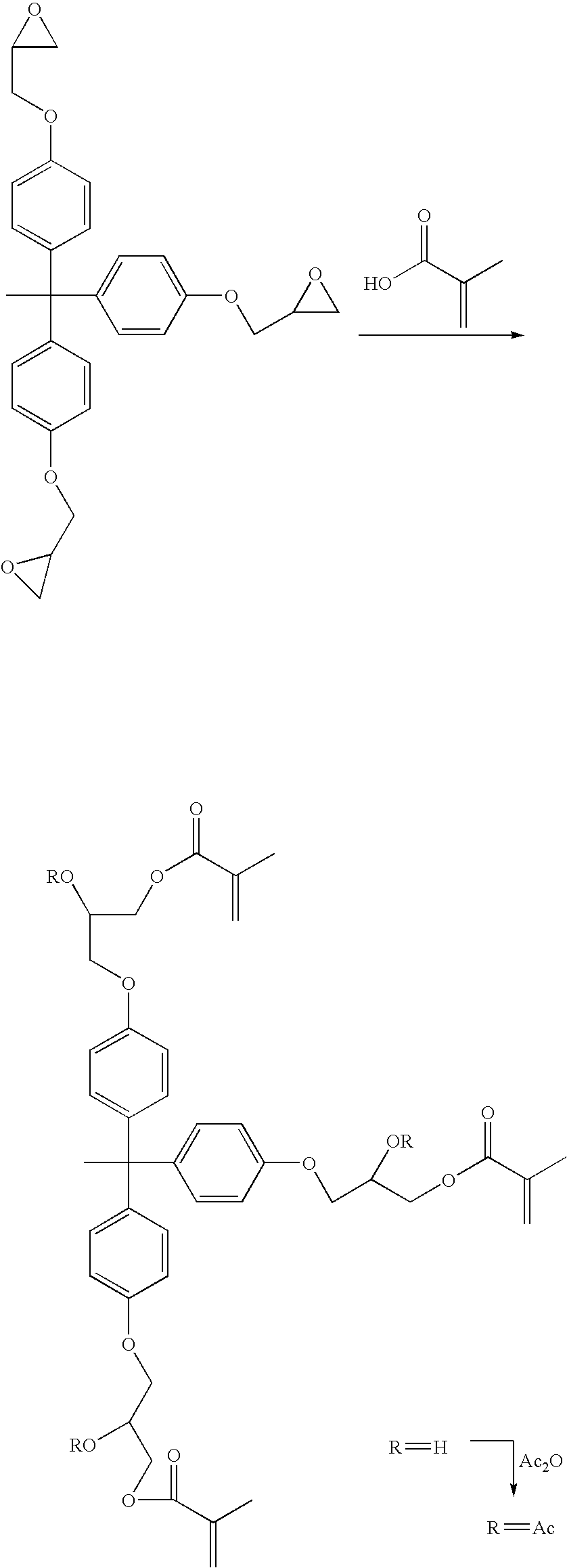Materials leading to improved dental composites and dental composites made therefrom
a technology of composite materials and materials, applied in the field of composite materials for restorative dentistry, can solve the problems of insufficient strength and toughness, leakage and bacterial reentry, and inability to offer the longevity of amalgam in dental fillings
- Summary
- Abstract
- Description
- Claims
- Application Information
AI Technical Summary
Problems solved by technology
Method used
Image
Examples
example 1
Synthesis of the Compound of Formula I Wherein each R1 is methyl, each R2 is —CH2CH2—, each R3 is H, R7 is methyl, and A is —[O—R6]n— where R6 is —CH2CH2—, and n is 1 (hereinafter “THPE GE Succinate HEMA”)
[0206] A 1 L three neck flask equipped with a mechanical stirrer, condenser, thermocouple, and addition funnel was charged with THPE GE (50 g, 0.105 mol), mono-2-(methacryloyloxy)ethyl succinate (77.6 g, 0.338 mol), triethylamine (1.0 g, 0.01 mol), and Prostab® 5415 (0.05 g,). The mixture was heated to 80° C. to obtain a pale yellow solution. The solution was stirred under nitrogen for 1 hour at 80° C. TLC (silica gel, 1 / 1 EtOAc / hexane) indicated no THPE GE remaining. The mixture was allowed to cool to 50° C. and then 500 mL EtOAc was added. The solution was washed with water (125 mL), saturated NaCl solution (100 mL), and then dried over MgSO4. Solvent was removed in vacuo at 50° C. / 0.5 torr for 2 hours to give 119.7 g (98.8%) of the desired product as a pale yellow viscous oil. ...
example 2
Synthesis of the Compound of Formula I Wherein each R1 is methyl, each R2 is —CH2CH2—, each R3 is Ac, R7 is methyl, and A is —[O—R6]n— where R6 is —CH2CH2—, and n is 1 (hereinafter “THPE GE Succinate HEMA Ac”)
[0207] A 1 L three neck flask equipped with a mechanical stirrer, condenser, thermocouple, and addition funnel was charged with THPE GE succinate HEMA that had been prepared as in Example 1 (100 g, 0.086 mol), acetic anhydride (35 g, 0.344 mol), pyridine (3.4 g, 0.043 mol), and Prostab 5415 (0.3 g). The orange solution was stirred for 3 hours at 60° C. It was allowed to cool to room temperature and then taken up in EtOAc (300 mL), washed with saturated NaHCO3 (125 mL, then 250 mL, let stir for 45 min), 10% HCl (2×100 mL), water (100 mL), saturated NaCl (100 mL), and then dried over MgSO4. Solvent was removed in vacuo on to 500 mL silica gel. The composite was applied to 700 mL silica in a 2 L coarse frit funnel and eluted with 1 L hexanes, 3 L 4 / 1 hexanes / EtOAc, 2 L 2 / 1 hexane...
example 3
Synthesis of the compound of formula I wherein each R1 is methyl, each R2 is —CH═CH—, each R3 is H, R7 is methyl, and A is —[O—R6]n— where R6 is —CH2CH2—, and n is 1 (hereinafter “THPE GE Maleate HEMA”)
[0208]
THPE GE Maleate HEMA
[0209] A 1 L three neck flask equipped with a mechanical stirrer, condenser, thermocouple, and addition funnel was charged with THPE GE (50 g, 0.105 mol), mono-2-(methacryloyloxy)ethyl maleate (77 g, 0.338 mol), triethylamine (1.0 g, 0.01 mol) and Prostab® 5415 (0.05 g). The mixture was heated to 80° C. to obtain a pale yellow solution. The solution was stirred under nitrogen for 1 hour at 80° C. TLC (silica gel, 1 / 1 EtOAc / hexane) indicated no THPE GE remaining. The mixture was allowed to cool to 50° C. and then 500 mL EtOAc was added. The solution was washed with water (125 mL), then saturated NaCl (100 mL), and then dried over MgSO4. Solvent was removed in vacuo at 50° C. / 0.5 torr for 2 hours to give 128 g of the desired product as a pale yellow viscous o...
PUM
| Property | Measurement | Unit |
|---|---|---|
| Fraction | aaaaa | aaaaa |
| Shrinkage | aaaaa | aaaaa |
| Shrinkage | aaaaa | aaaaa |
Abstract
Description
Claims
Application Information
 Login to View More
Login to View More - R&D
- Intellectual Property
- Life Sciences
- Materials
- Tech Scout
- Unparalleled Data Quality
- Higher Quality Content
- 60% Fewer Hallucinations
Browse by: Latest US Patents, China's latest patents, Technical Efficacy Thesaurus, Application Domain, Technology Topic, Popular Technical Reports.
© 2025 PatSnap. All rights reserved.Legal|Privacy policy|Modern Slavery Act Transparency Statement|Sitemap|About US| Contact US: help@patsnap.com



